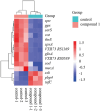Potential antibacterial effects and transcriptomic analysis of a novel reversible photoacid-based crystalline coordination polymer
- PMID: 40727557
- PMCID: PMC12301377
- DOI: 10.3389/fmicb.2025.1624377
Potential antibacterial effects and transcriptomic analysis of a novel reversible photoacid-based crystalline coordination polymer
Abstract
Introduction: With the increasing prevalence of antibiotic resistance, the development of novel antibacterial materials is crucial to combat clinically relevant pathogens. This study comprehensively investigated the antibacterial properties and underlying mechanisms of a novel reversible photoacid-based crystalline material.
Methods: The antibacterial efficacy of the material was evaluated against six clinically relevant pathogenic bacteria, including multidrug-resistant strains. The inhibition rates were determined, and scanning electron microscopy (SEM) was used to observe the effects on cell surface integrity. Transcriptomic analysis was conducted to elucidate the underlying antibacterial mechanisms.
Results: The material exhibited broad-spectrum antibacterial activity, with higher sensitivity toward Gram-negative bacteria. Blue light irradiation significantly enhanced its antibacterial efficacy. SEM revealed that the material disrupted cell membrane integrity, leading to cell death. Transcriptomic analysis showed that the material inhibited bacterial protein synthesis, disrupted cell membrane protein synthesis, and downregulated oxidative stress-related genes, causing ROS accumulation and inhibiting cell growth.
Discussion: These findings provide a theoretical basis for the potential clinical application of this material as a new antibacterial agent. The material's ability to enhance antibacterial efficacy through light irradiation and its broad-spectrum activity suggest it could be a valuable tool in combating antibiotic-resistant pathogens. Future research should focus on further exploring the antibacterial mechanisms and evaluating the material's safety and efficacy in clinical settings.
Keywords: SEM; clinical pathogens; inhibition rate; photoacid; transcriptomic analysis.
Copyright © 2025 Zheng, Zheng, Wu, Zheng, Yu, Qiu, Chen, Chen, Li, Liao and Hu.
Conflict of interest statement
The authors declare that the research was conducted in the absence of any commercial or financial relationships that could be construed as a potential conflict of interest.
Figures





Similar articles
-
Exploring the additive antibacterial potential of Cinnamomum cassia volatile oil and imipenem against Acinetobacter baumannii: a multi-omics investigation.Front Microbiol. 2025 Jul 2;16:1578322. doi: 10.3389/fmicb.2025.1578322. eCollection 2025. Front Microbiol. 2025. PMID: 40673148 Free PMC article.
-
A systematic review on natural products with antimicrobial potential against WHO's priority pathogens.Eur J Med Res. 2025 Jul 1;30(1):525. doi: 10.1186/s40001-025-02717-x. Eur J Med Res. 2025. PMID: 40597250 Free PMC article.
-
Management of urinary stones by experts in stone disease (ESD 2025).Arch Ital Urol Androl. 2025 Jun 30;97(2):14085. doi: 10.4081/aiua.2025.14085. Epub 2025 Jun 30. Arch Ital Urol Androl. 2025. PMID: 40583613 Review.
-
Eliciting adverse effects data from participants in clinical trials.Cochrane Database Syst Rev. 2018 Jan 16;1(1):MR000039. doi: 10.1002/14651858.MR000039.pub2. Cochrane Database Syst Rev. 2018. PMID: 29372930 Free PMC article.
-
Antibacterial activity and mechanism of naphthoquine phosphate against ceftazidime-resistant Acinetobacter baumannii via cell membrane disruption and ROS induction.Front Microbiol. 2025 Aug 4;16:1603462. doi: 10.3389/fmicb.2025.1603462. eCollection 2025. Front Microbiol. 2025. PMID: 40831639 Free PMC article.
References
LinkOut - more resources
Full Text Sources

